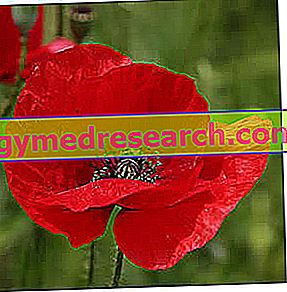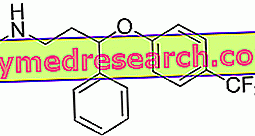Goodnight grass
Among the so-called goodnight herbs, red poppy, commonly known as rosolaccio, cannot be omitted. Also Celso describes the plant for its marked sedative action: from his writings it can be deduced that by boiling the red poppy in the wine of dried grapes a useful drink is obtained to favor the fall asleep.

In the context of ancient folk medicine, the infusion or decoction of red poppy was also useful to counter cough, lighten bronchial irritation, and decrease bluetongue and rheumatic fever. [from E. Campanini's Dictionary of herbal medicine and medicinal plants ]
Before we dwell on the active ingredients and the phytotherapeutic properties attributed to the red poppy, we will briefly analyze the plant in a botanical key.
Botanical analysis
Red poppy is a delicate, delicate herbaceous plant belonging to the Papaver family ; its height generally does not exceed 60-80 centimeters. The stem of the rosolaccio, erect and hairy, shows non-enveloping toothed leaves, with pointed or oblong lobes, deeply divided into lanceolate segments. The slender trunk shows unmistakable flowers, with the typical purple-red color stained internally by a small black imprint. When the petals, hidden inside green sepals before the bloom, fall, they give life to a small hairless capsule (fruit).
The flower, simple but beautiful and elegant, is very common both in cultivated fields (especially in wheat), and in uncultivated ones, and grows up to an altitude of 1, 700 meters: so much so that red poppy is also considered a weed.
Chemical analysis
Being an exponent of the Papaveraceae, also the red poppy contains alkaloids: the whole plant - except for the seeds - contains roeadin and other isoquinolic alkaloid molecules. The aerial parts abound in protopine (also present in the roots), sanguinarine, coptisin and cheleritrina.
Other chemical components include mucilages and anthocyanins, which are responsible for the red blood color of the petals (in this regard, anthocyanins are also used as colorants).
From the seeds an oil rich in linoleic, stearic, palmitic and oleic acid is obtained.
In phytotherapy, the most exploited part of the plant is represented by the petals.
[chemical composition of red poppy from the Phytotherapy and Medicinal Plants Dictionary, by E. Campanini]
Although the red poppy and the opium poppy belong to the same family, the phytocomplex is very different: in addition to the absence of morphine, codeine and papaverine (molecules that characterize the phytocomplex of the species somniferum ), the entire red poppy plant is constituted from latex very different from that of the other species.
Therapeutic uses and activities
In the introductory part of the article we mentioned the most important properties associated with red poppy: below they will be analyzed in more detail.
First of all, since the poppy is a goodnight herb, one of the most important medicinal virtues is undoubtedly the sedative one: in particular, the poppy extracts are indicated in the formulation of natural products favoring the sleep of infants. It is important to remember that poppy extracts can be combined with the phytocomplex of other drugs with sedative action, in order to enhance the final effect. In addition to the pediatric age, red poppy-based products are also recommended for senescence, considering that the drug's side effects are almost nil.
The sedative activity is not the only ascribed to the phytocomplex: the red poppy is widely used for its bechiche properties, that is useful to counter cough in general: therefore, it is recommended to counteract the whooping cough, to calm the cough and to lighten acute catarrhal bronchitis.
The antitussive activities are made by the active ingredients extracted from the flowers, able to favor expectoration and, at the same time, to calm the spasm.
Finally, the red poppy extract has proved to be an excellent diaphoretic, useful for lowering flu fever, favoring sweating.
By applying the extract on the spot - in the form of ointments or ointments - the red poppy is used as a soothing and anti-reddening agent on irritated and reddened skin.
Lastly, the anthocyanins made from red poppy flowers are used as a colorant.
Side effects
In general, the use of red poppy in phytotherapy is almost harmless. Clearly, a doctor's opinion is advised during pregnancy and lactation before taking red poppy extracts.
Given the sedative action, the concomitant intake of hypnotic-sedative substances is not recommended.
Synergistic action
Examples of synergism between red poppy and other drugs
Herbal teas with sedative action :
|
Herbal tea for cough (expectorant action):
|
Red poppy in brief, summary »



